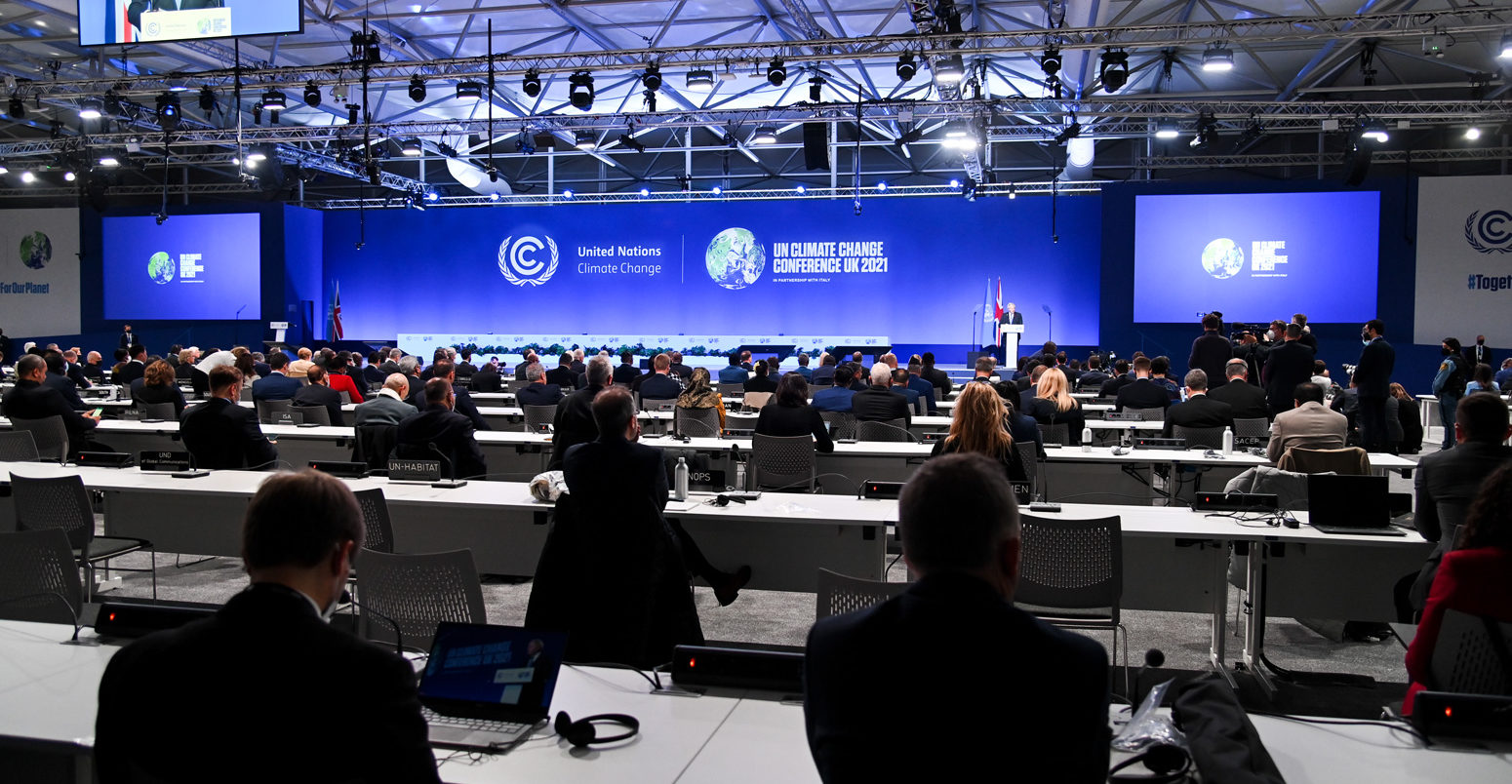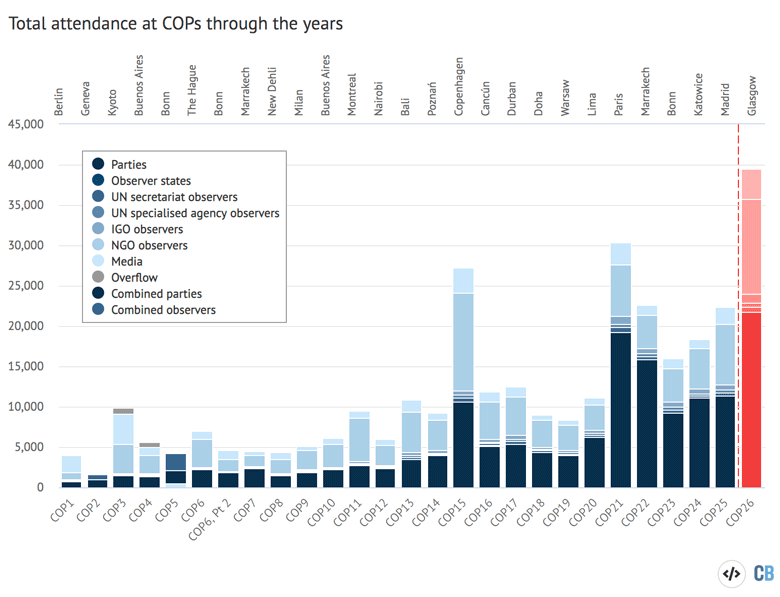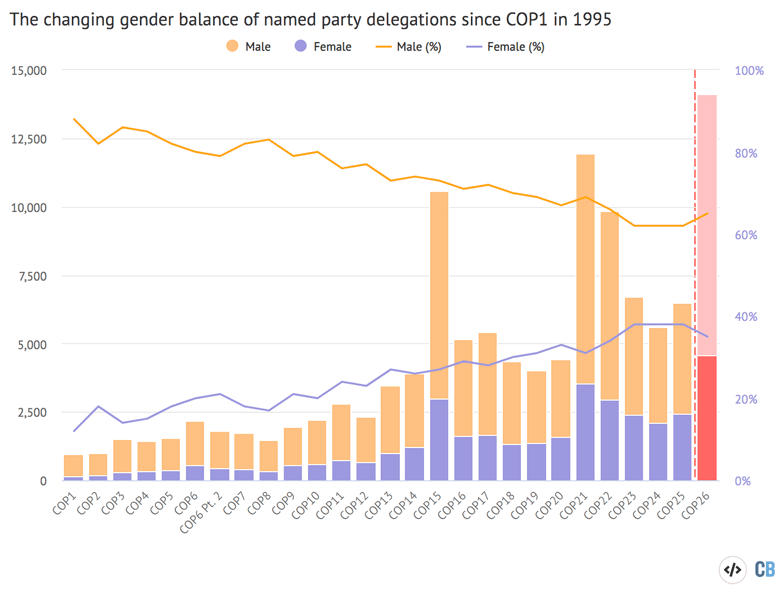
Analysis: Which countries have sent the most delegates to COP26?
Robert McSweeney
11.03.21Robert McSweeney
03.11.2021 | 1:13pmAlmost 40,000 delegates registered for the 26th Conference of the Parties (COP26) climate summit, the provisional list shows, suggesting that the Glasgow event is the biggest COP to date.
This will come as no surprise to those who have encountered the queues to get into the venue, which neared capacity on each of the first two days. The COP26 organisers subsequently apologised to delegates via email.
However, with the disruption to travel plans caused by Covid-19, as well as visa and accreditation problems, the final participant numbers – published after the summit is over – may indicate that many of those who registered to attend were unable to make the trip.
There are notable absences in the published lists – including no registered participants from Afghanistan, Myanmar or Kiribati. And Carbon Brief has been told that other small island states – including Vanuatu and Samoa – have not been able to send delegates, despite having teams registered.
In this article, Carbon Brief delves into the data, revealing that Brazil has registered the largest party delegation this year, while the average gender balance across all party delegations is less equal than at the last three COPs.
(Update 02/12/2021: The UNFCCC has now published the final COP26 participant lists. A total of 38,457 delegates attended, confirming the summit’s status as the largest in history.)
Largest COP
According to the provisional list (pdf) published by the United Nations Framework Convention on Climate Change (UNFCCC), a total of 39,509 participants registered for COP26.
This total makes COP26 comfortably – albeit provisionally – the most well-attended COP in history. It tops both COP21 in Paris (30,372) and COP15 in Copenhagen (27,301).

The largest group at COP26 is for delegates representing parties – nation states, plus the European Union, that have ratified the Convention and play a full part in negotiations. This group adds up to 21,688 delegates – more than double the number “anticipated” by the UNFCCC before the COP.
There are also observer states that have not completed ratification. For the fifth COP in a row, the Holy See is the only observer state, bringing an all-male delegation of seven people.
The next-largest group is that of non-governmental organisations (NGOs), which totals 11,734 participants. This is a jump up from 7,417 NGO participants at COP25 in Madrid, but not as many as the 12,048 that attended COP15.
Along with the NGOs, there are several other groups that fall into the category of “observer organisations” – such those participants representing UN bodies, intergovernmental organisations, other agencies and business representatives. These total 2,299 registered delegates.
Finally, a record number of media participants have registered for COP26. The total of 3,781 surpasses COP3 in Kyoto in 1997 (3,712) and COP15 (3,221) and is higher than the published UNFCCC limit for COP26 of 3,000.
Brazil sends biggest delegation
In addition to the overall totals, the UNFCCC also publishes a partial breakdown of each party and observer delegation by name. From these lists, Carbon Brief has calculated the size of each named party delegation.
(These named lists do not include all participants. There are also party “overflow” delegates, which parties can nominate without their names appearing on the official list.)
Analysis published last week by Carbon Brief on how the number of delegates has changed across all COPs since the 1990s showed that Brazil brings, on average, the largest named delegation.
True to form, Brazil also has the largest party delegation at COP26, clocking in at 479. This is their second largest named delegation after COP15 (566).
After Brazil, the next largest is Turkey (376), followed by the Democratic Republic of the Congo (373), Ghana (337) and Russia (312).
The UK, as hosts, has the 10th largest delegation, with 230 participants registered. Among those listed are Prince William and Kate, the Prince of Wales and the Duchess of Cornwall, and Sir David Attenborough.
(It is worth noting that some countries allocate some of their party badges to NGOs, which can artificially inflate the size of their official delegation.)
Several nations have no registered delegates at this year’s COP. One of these in Afghanistan, which may not be a surprise considering the turmoil of recent months as the Taliban seized power. In the previous five COPs, Afghanistan has sent an average of 13 people.
Elsewhere, Kiribati and Myanmar also did not register a delegation, despite each bringing an average of around 20 people to the last five COPs.
Kelvin Anthony, a Pacific fellow at the Climate Vulnerable Forum, tells Carbon Brief that Covid-19 travel restrictions have “severely impacted Pacific island nations’ ability to travel to COP26”. He says that Kiribati does have “some representatives” in Glasgow, but “they did not travel from the island but instead are representatives based in other countries as senior officials at consulates”.
However, he adds, many other nations have decided to not attend “fearing taking the Covid-19 virus back to their islands, which have remained Covid-free” to date. He notes that Vanuatu and Samoa fall into this category.
Less balanced
The UNFCCC’s list provides the name and title of each registered participant. Therefore, it is possible to work out the balance of men to women that each country has sent to Glasgow.
(It should be noted that the gender balances presented here are based on the titles designated by UNFCCC and not by Carbon Brief. In addition, Carbon Brief recognises that gender is not best categorised using a binary “male” or “female” label and appreciates that the UNFCCC’s lists may not be wholly accurate.)
Over the history of the COPs, the gender balance of named party delegations has gradually become less unequal. While the average delegation at COP1 was 88% male and 12% female, this shifted over time so that each of the last three COPs had an average gender balance of 62% male to 38% female.
However, at COP26 this shift has tilted the other way, with an average balance of 65% male to 35% female.

There are four all-male named delegations registered for COP26 – Yemen, Turkmenistan, North Korea and Holy See. In contrast, none is all-female, although there are 27 parties that have more female delegates than male.
The most female-led delegations are the Republic of Moldova (89% female to 11% male), Samoa (79%-21%) and Mexico (78%-22%).
The UK is one of eight delegations with a 50-50 gender balance.
The map and chart below present the delegation size and gender balance for all the countries registered for COP26. The darker the shading, the more delegates that country has signed up. Mouse over the countries to see the number of delegates and the population size.
The full list of COP26 party delegation sizes and their gender balances can be found here.

